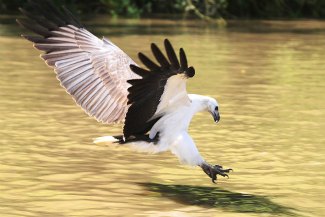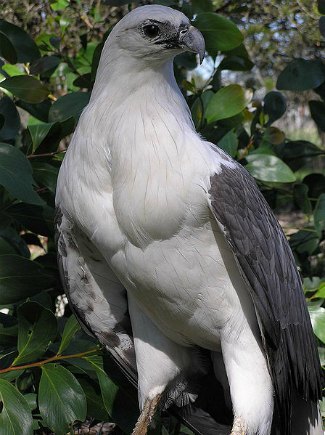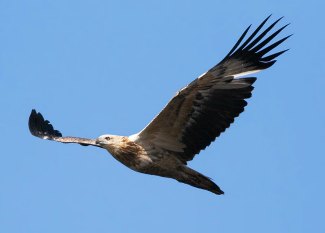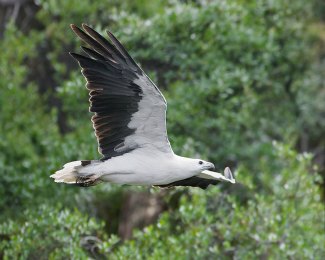White-Bellied Sea Eagle - Haliaeetus leucogaster
By Mdk572, CC-BY-SA-3.0, via Wikimedia Commons
Family: Accipitridae
Genus: Haliaeetus
Species: H. leucogaster
White-Bellied Sea Eagles are large gray and white raptors that live from southeast Asia to Australia and Tasmania. They occur in a range of habitats and have a highly varied diet. They form a clade with H. sanfordi (Sanford's Sea Eagle), H. vocifer (African Fish Eagle), and H. vociferoides (Madagascar Fish Eagle), in addition to forming a superspecies with H. sanfordi.
Physical Description:
White-Bellied Sea Eagles have a gray-brown back and wing coverts and are white along the head, neck, tail, underside, and thighs. The primary feathers and tail base are black. The eyes are black-brown and the cere and lores are blue-gray; the tarsi are unfeathered. Their beak is large in proportion to their narrow head, and the neck and wings are long.
Juveniles are dark brown from above and have a cream-colored head with dark brown stripes behind the eyes. There is buff streaking along the back and shoulders. The tail is white with a black subterminal band and dark brown underside and there are light wing panels across the greater and inner wing coverts. Juveniles reach full adult plumage after 5-6 years, which is around the time they begin breeding.
White-Bellied Sea Eagles are noisiest before they lay their eggs, particularly in the morning and at dusk. Their call is a loud and honking "ank ank ank" and in courtship, a faster "ka ka ka". They can be heard up to a distance of 1 km. Listen to a recording.
Their maximum lifespan is around 30 years.
Size:
Length: 70-85 cm
Wingspan: 180-220 cm
Weight: Male: 1.8-2.9 kg. Female: 2.5-3.9 kg.
Habitat and Distribution:
They have been recorded in coastal habitats, estuaries, lakes, artificial reservoirs, riverbanks, swamps, billabongs, sewage ponds, grassland, woodland, rainforest, and urban areas. They usually live from 0-900 m above sea level but have been recorded as high as 1,700 m in Sulawesi.
They inhabit India, southern China, southeast Asia, Indonesia, the Philippines, Papua New Guinea, Australia, and Tasmania, from 26°N to 44°S. Adults are irruptive or local migrants and juveniles disperse from breeding areas, traveling up to 3,000 km from their nesting sites in Australia; a few breeding adults along southern inland rivers of Australia migrate during the winter. There are an estimated 1,000-10,000 individuals.
Diet and Hunting:
White-Bellied Sea Eagles have a large diet that includes reptiles, fish, birds, mammals, crustaceans, offal, floating refuse, carrion, and human waste. Reptiles include snakes, turtles and tortoises; birds include gulls, terns, cormorants, ducks, geese, and chickens; and mammals include bandicoots, wallabies, rodents, rabbits, and fruit bats. They also prey on poisonous fish and sea snakes.
They still-hunt from a perch or soar 10-20 m above the surface of the water to forage for food, though rarely breaking the surface of the water when catching animals—unlike some other birds that submerge completely. Kleptoparasitism is common behavior (as with many other eagles) and they steal prey from ospreys, kites, and other White-Bellied Sea Eagles. Occasionally they hunt cooperatively. They are also known to follow harvesters and dolphins for prey disturbed by their passing and to drop crabs from 30-40 m in the air to break open their shells.
By Noodle snacks, CC-BY-SA-3.0, via Wikimedia Commons
Reproduction:
Breeding displays consist of high and low circling, chases, dives, somersaults, claw-grappling, and cartwheeling. The breeding season is from October-March in India, December-May in southeast Asia, the Philippines, and Borneo, May-November in New Guinea and northern Australia, and June-December for populations further south. Pairs are monogamous.
The nest is 1.2-1.5 m across and can grow to be 3.5 m deep and 2 m with repeated use. It is lined with green leaves, grass, and seaweed and placed in a mangrove or forest tree 3-50 m high; alternatively, it will be built on a cliff 9-70 m high. 1-3, usually 2, white or dull white eggs are laid and incubated for 35-42 days, mostly by the female. Fledging takes 65-70 days and juveniles remain with their parents for 3-6 months after that. Cainism, also known as siblicide (where the older chick kills the younger), is common in behavior in southern China, but in Australia 36% of nesting sites successfully raise more than one chick. White-Bellied Sea Eagles first breed after around 6 years.
Conservation:
They are listed as Vulnerable in Tasmania, Threatened in Victoria, Endangered in South Australia, and Vulnerable status has been proposed in New South Wales; the population is thought to be in decline overall. White-Bellied Sea Eagles are threatened by shooting, poisoning, and clearance of forests near waterside habitats. Pesticides such as DDT may also be a threat. They are currently listed globally as Least Concern by BirdLife International.
By JJ Harrison, CC-BY-SA-3.0, via Wikimedia Commons
Taxonomy:
Haliaeetus leucogaster forms a clade with H. sanfordi (Sanford's Sea Eagle), H. vocifer (African Fish Eagle), and H. vociferoides (Madagascar Fish Eagle) and a superspecies with H. sanfordi. It is thought that H. sanfordi evolved from H. leucogaster due to a small genetic difference found between the two species, a difference no greater than what is usually found among members of the same species. However, the two are classified separately by several authorities due to differences in behavior and morphology.
The eagle genus Haliaeetus is closely related to the kite genera Milvus and Haliastur.
Other Names:
Gray-Backed Sea Eagle, White-Bellied Fish Eagle, White-Breasted Fish Eagle, White-Bellied Fish-Hawk, Hvidbrystet Havørn (Danish), Witbuikzeearend (Dutch), Valkomerikotka (Finnish), Pygargue blagre (French), Weißauch-Seeadler (German), Kohassa (Hindi), Elang laut, Elang laut perut putih (Indonesian), Aquila di mare ventrebianco (Italian), Shiroharaumiwashi (Japanese), Burung Hamba Siput (Malay—it means "slave to shellfish", in reference to a traditional belief that the eagles called to alert shellfish that ocean tides had changed), Hvitbukhavørn (Norwegian), Pigargo Oriental (Spanish), Vitbukad havsørn (Swedish), Kadal ali (Tamil).
Video of a White-Bellied Sea Eagle nest:
References:
http://avibase.bsc-eoc.org/species.jsp?avibaseid=94383EEF1D9DD75A
Anonymous. 2012 Haliaeetus leucogaster - J. F. Gmelin, 1788 (White-bellied Sea-Eagle ) in Deomurari, A.N. (Compiler), 2010. AVIS-IBIS (Avian Information
System - Indian BioDiversity Information System) v. 1.0. Foundation For Ecological Security, India retrieved on 04/12/2012
BirdLife International (2012) Species factsheet: Haliaeetus leucogaster. Downloaded from http://www.birdlife.org on
20/04/2012.
http://www.birdsinbackyards.net/species/Haliaeetus-leucogaster
Department of Sustainability, Environment, Water, Population and Communities (2012).Haliaeetus leucogaster in Species Profile and Threats Database,
Department of Sustainability, Environment, Water, Population and Communities, Canberra. Available from:
http://www.environment.gov.au/sprat. Accessed Sat, 21 Apr 2012 00:25:35 +1000.
Global Raptor Information Network. 2012. Species account: White-bellied Sea Eagle Haliaeetus leucogaster. Downloaded from
http://www.globalraptors.org on 20 Apr. 2012
http://ibc.lynxeds.com/species/white-bellied-sea-eagle-haliaeetus-leucogaster
BirdLife International 2009. Haliaeetus leucogaster. In: IUCN 2011. IUCN Red List of Threatened Species. Version 2011.2.
www.iucnredlist.org. Downloaded on 20 April 2012.
http://www.naturia.per.sg/buloh/birds/Haliaeetus_leucogaster.htm
Ferguson-Lees, James, and Christie, David A. Raptors of the World. Houghton Mifflin Company, 2001.
http://www.travelling-australia.info/InfsheetsH/Haliaeetus_leucogaster.html



